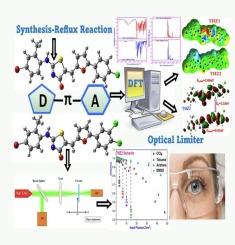Solvent effect and intensity dependence on NLO behaviour of thiazole-furan chromophores: An optical limiting application
IF 5.2
2区 化学
Q2 CHEMISTRY, PHYSICAL
引用次数: 0
Abstract
This study deals with the synthesis, structural characterization, and nonlinear optical properties of thiazole-furan-based push-pull chromophores. Experimental and computational methods have been used to investigate the unique features and potential optical limiting applications. Synthesized chromophores were confirmed using 1H and 13C NMR spectroscopy. Density Functional Theory calculations in polar and nonpolar solvents were employed to evaluate how solvent interactions influence the electronic properties and stability of the molecules. Vibrational mode assignments were performed using normal coordinate analysis, providing insight into the molecular vibrations. Furthermore, Natural Bond Orbital analysis offered a detailed examination of the charge distribution and electronic delocalization patterns within the chromophoric system. The nonlinear optical properties were investigated using the Z-scan technique to determine their nonlinear absorption coefficients and suitability for optical limiting applications. These findings emphasize the compounds' enhanced hyperpolarizabilities, excellent thermal stability, and potential for use in advanced photonic devices. This research highlights the importance of solvent effects and molecular conformation in designing high-performance materials for next-generation photonic technologies.

噻唑-呋喃发色团NLO行为的溶剂效应和强度依赖性:光学限制应用
本文研究了噻唑-呋喃基推拉发色团的合成、结构表征和非线性光学性质。实验和计算方法被用来研究其独特的特性和潜在的光学限制应用。合成的发色团经1H和13C核磁共振确证。采用密度泛函理论计算极性和非极性溶剂,以评估溶剂相互作用如何影响分子的电子性质和稳定性。使用正坐标分析进行振动模式分配,从而深入了解分子振动。此外,自然键轨道分析提供了对显色体系内电荷分布和电子离域模式的详细检查。利用z扫描技术研究了其非线性光学性质,确定了其非线性吸收系数及其在光学限制应用中的适用性。这些发现强调了该化合物具有增强的超极化性、优异的热稳定性以及在先进光子器件中的应用潜力。本研究强调了溶剂效应和分子构象在设计下一代光子技术高性能材料中的重要性。
本文章由计算机程序翻译,如有差异,请以英文原文为准。
求助全文
约1分钟内获得全文
求助全文
来源期刊

Journal of Molecular Liquids
化学-物理:原子、分子和化学物理
CiteScore
10.30
自引率
16.70%
发文量
2597
审稿时长
78 days
期刊介绍:
The journal includes papers in the following areas:
– Simple organic liquids and mixtures
– Ionic liquids
– Surfactant solutions (including micelles and vesicles) and liquid interfaces
– Colloidal solutions and nanoparticles
– Thermotropic and lyotropic liquid crystals
– Ferrofluids
– Water, aqueous solutions and other hydrogen-bonded liquids
– Lubricants, polymer solutions and melts
– Molten metals and salts
– Phase transitions and critical phenomena in liquids and confined fluids
– Self assembly in complex liquids.– Biomolecules in solution
The emphasis is on the molecular (or microscopic) understanding of particular liquids or liquid systems, especially concerning structure, dynamics and intermolecular forces. The experimental techniques used may include:
– Conventional spectroscopy (mid-IR and far-IR, Raman, NMR, etc.)
– Non-linear optics and time resolved spectroscopy (psec, fsec, asec, ISRS, etc.)
– Light scattering (Rayleigh, Brillouin, PCS, etc.)
– Dielectric relaxation
– X-ray and neutron scattering and diffraction.
Experimental studies, computer simulations (MD or MC) and analytical theory will be considered for publication; papers just reporting experimental results that do not contribute to the understanding of the fundamentals of molecular and ionic liquids will not be accepted. Only papers of a non-routine nature and advancing the field will be considered for publication.
 求助内容:
求助内容: 应助结果提醒方式:
应助结果提醒方式:


